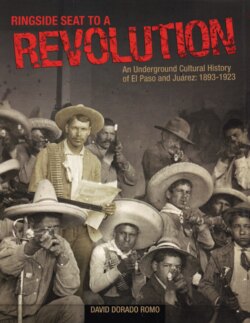Читать книгу Ringside Seat to a Revolution - David Dorado Romo - Страница 55
На сайте Литреса книга снята с продажи.
Оглавление• 1893-1894—Revolutionist
Was the first Mexican American to launch a revolutionary expedition from El Paso against the gov-
ernment of Porfirio Díaz.
• 1895-1897—Federal Prisoner
Convicted of neutrality law violations at El Paso’s Federal Courthouse in 1895. Served a two-and-
a-half year sentence in King’s County Federal Prison. His U.S. citizenship was stripped but later
restored by Theodore Roosevelt by a special presidential decree on February 15, 1906.
• 1897-1912—Inventor
He patented a magnetic brake for streetcars, a fountain pen, a holder for fountain pens, a revolv-
ing sign board, an improved windmill attached to a generator which harnessed wind into electric-
ity and an adjustable clincher wrench he called “Ochoa’s Chicken Pliers.” His flying machines were
not patented.
• 1897-1912—Corporate President
President of the International Airship Company and the Ochoa Tool and Machine Company.
• 1892-1930—Writer
In addition to writing for his own newspaper El Hispano-Americano, he also submitted articles to
New York flight magazines and editorials to the El Paso Herald. He wrote a strange, somewhat sur-
real novel called The Wise Man of the Land of Moctezuma (which was never published) about an
Aztec visionary and healer by the name of Mimo Abas. His central character, who undoubtedly is
partly based on Ochoa himself, was “not only a wonderful reasoner, but also a great and indefati-
gable experimenter.”110 He also wrote a tragicomic essay entitled “The Making of an American” set
in El Paso during WWI which relates the personal misfortunes of Pedro Calderón, a Mexican who
falls in love with an Anglo girl and decides to become an American.111
• 1912—Director of Intelligence Agency
Victor decided to return to El Paso in 1912, where he headed the espionage agency in the border
city for the Orozquistas. The Orozquistas had risen against President Madero because they felt he
had betrayed the original ideals of the revolution. He came up with some wildly inventive ideas
to win the espionage war in the city—such as offering $5,000 to blow up the Mexican consulate
in El Paso or organizing a jailbreak to liberate Orozquistas from the city jail.112
• 1912-1915—Arms smuggler
Smuggled arms and ammunition for both the Orozquistas (1912) and Carrancistas (1915). On April
1915, Ochoa was arrested in El Paso and charged with smuggling a carload of ammunition for the
Carrancistas.113 He served two years for neutrality violations at Leavenworth penitentiary from 1917
to 1919.
• 1914-1915—Narcotraficante
Exploiting the knowledge and underground connections he acquired from smuggling arms, Ochoa
turned his trafficking business into a two-way street. From El Paso to Juárez, he smuggled guns
and bullets; from Juárez to El Paso, it was opium and morphine.
110
Victor L. Ochoa Papers. Like Victor Ochoa, the novel’s main character is also ahead of his time. Mimo Abas carries out experiments on simple
cells using the principles of electromagnetic emulsion. His mission is to try to reverse the custom among his Aztec community to purposely
deform their children so that they would be spared from becoming human sacrifice. The Indian wise man carries out blood transfusions that
combined the blood of animals such as bulls, dogs, snakes, goats and sheep with that of human beings. “By infusing the blood of the ox he
secured a wonderfully powerful set of men and women, very slow in their movements, true, but steadfast and faithful workers, and harmless in
their disposition,” Ochoa wrote. “These couples gave Abas the greatest satisfaction from his many experiments.” The wise man’s accomplish-
ments, however, merely threaten the Aztec rulers. “He became the target for all the vituperation and vilification of the Indian high priests, who
were bent not only upon the destruction of his teachings, but also made him the object of a persecution…notwithstanding that in all his life the
great Mimo Abas had done wonders for his fellows.”
111
Victor L. Ochoa Papers, National Museum of American History. Pedro Calderón crosses the Juárez International Bridge where he has to pay a $10
head tax. Pedro pays it figuring, “I could not go very well without my head.” Then he’s taken to a room at customs where he is deloused, sprayed
and bathed with creosote. “Of course, I had no lice,” Pedro remarks, “but just the same they kept sousing me in that creosote.” He’s finally
allowed into the country, watches his first baseball game, but can’t understand why the umpire has a muzzle over his face. “I thought to myself
he must be a dangerous man to be muzzled so.” He sits down in a park bench in the Second Ward and is immediately arrested by a policeman
for vagrancy and is sentenced to 200 days of hard labor for the crime of being moneyless and unemployed in America. After working in a chain
gang at a rock pile for 100 days he’s offered the opportunity to join the army and fight with Pershing’s troops in Europe, which he does. After
the war he returns to El Paso with lots of war medals, but still no job. His sweetheart, in the meantime, has married someone else.
112
Charles Harris and Louis Sadler. The Border and the Revolution, p. 60.
113
El Paso Herald, April 16, 1915.
50
